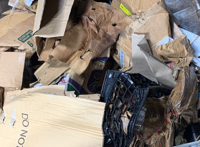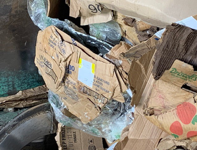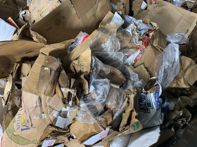 Bottles, cans and plastic wrap. Plastic milk crates. Even an office chair and a toilet seat. They’re all things that Miller Recycling has recently found mixed into incoming loads of recovered cardboard. Cardboard contamination is a global problem, and it’s not new—but developments over the last few years have made cardboard contamination a much more expensive problem than it was before.
Bottles, cans and plastic wrap. Plastic milk crates. Even an office chair and a toilet seat. They’re all things that Miller Recycling has recently found mixed into incoming loads of recovered cardboard. Cardboard contamination is a global problem, and it’s not new—but developments over the last few years have made cardboard contamination a much more expensive problem than it was before.
How Cardboard Contamination Happens
 “Cardboard contamination” really describes two problems. Cardboard that’s greasy, wet, moldy, has food debris attached or is otherwise dirty is considered contaminated because it can’t be processed, recycled and turned into new materials. A load of recovered cardboard is also considered contaminated when non-cardboard items are mixed in – even when those items are themselves recyclable.
“Cardboard contamination” really describes two problems. Cardboard that’s greasy, wet, moldy, has food debris attached or is otherwise dirty is considered contaminated because it can’t be processed, recycled and turned into new materials. A load of recovered cardboard is also considered contaminated when non-cardboard items are mixed in – even when those items are themselves recyclable.
Some of the cardboard contamination that we see come through our facility can probably be attributed to wish-cycling. When someone puts greasy pizza boxes in a cardboard recycling container, it’s probably because they simply think “cardboard gets recycled.” They think they’re making the right choice by putting something made of cardboard into that container. If they do stop and wonder whether greasy cardboard belongs in the trash or recycling, they might still put it in recycling—optimistically hoping that the box might be able to be turned into something new.
Recycling contamination is also caused by inattention. Some people just don’t think about recycling or pay attention to what kind of container they’re throwing things into. Businesses sometimes accommodate this kind of passive negligence by not providing clearly distinct recycling containers. If the trash room has two identical black Dumpsters with small labels, people will inevitably throw trash into the cardboard bin and cardboard into the trash bin. Or, if business leaders never train employees to be careful about separating trash from recycling, some workers may think it’s not a problem to toss soda bottles and food wrappers into a cardboard baler or bin if it’s closer than a trash can is.
The Price of Cardboard Contamination
 Cardboard contamination has always been a problem for recycling companies. Cardboard is one of the most commonly recycled materials that businesses and individuals generate. There’s always been some confusion about whether dirty cardboard should be recycled, and it’s always been common for loads of recovered cardboard to be contaminated by trash or other non-cardboard items.
Cardboard contamination has always been a problem for recycling companies. Cardboard is one of the most commonly recycled materials that businesses and individuals generate. There’s always been some confusion about whether dirty cardboard should be recycled, and it’s always been common for loads of recovered cardboard to be contaminated by trash or other non-cardboard items.
Recyclers used to be more willing to accept contaminated loads of cardboard, even though sorting and processing the material could be challenging, because foreign importers would still buy recovered cardboard from American recyclers. That changed in 2018, when China’s crackdown on foreign recyclables rocked the industry. The country’s processing facilities had become overwhelmed by loads of contaminated material being shipped in from the U.S. and other countries.
With the enactment of the National Sword policy, China banned many kinds of recycled imports and placed strict quality controls on other materials. American recyclers essentially lost their number one customer for recovered plastic and other recyclables. While foreign importers outside of China still buy cardboard and other materials, everyone has started cracking down on contaminated shipments. A load of cardboard may be inspected before it’s accepted through customs. Inspectors will open random bales and reject the load if they find too much contamination.
As you can imagine, having a shipment turned away from a foreign port halfway around the world is a very expensive and complicated problem for recyclers! So ensuring that a load of recovered cardboard will be accepted for sale falls to the recycling companies that buy this material from individuals and businesses. The more contaminated a load of cardboard is, the more time it takes to sort and process. The recycling company ends up spending more on labor and operational costs than it would to process an equivalent load of clean cardboard.
 Ultimately, contamination is an issue that affects everyone who recycles cardboard, and every company that supplies or buys recovered cardboard. When recyclers incur greater costs to process and sell recovered materials, customers see it reflected in the prices they’re able to get for their materials.
Ultimately, contamination is an issue that affects everyone who recycles cardboard, and every company that supplies or buys recovered cardboard. When recyclers incur greater costs to process and sell recovered materials, customers see it reflected in the prices they’re able to get for their materials.
Miller Recycling urges all customers to be diligent about keeping trash and other contaminants out of your cardboard recycling containers. We really don’t want to have to adjust our pricing because of cardboard contamination, but it may be unavoidable. If you have any questions about the right way for your business to manage its used cardboard, contact me today!

